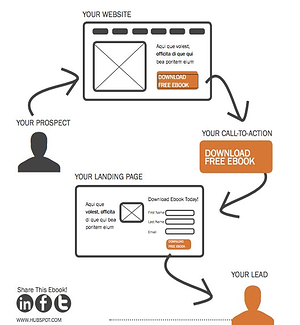
Inbound marketing is a proven lead generation channel for SMB companies. As we've mentioned in previous articles, the success of your inbound marketing efforts is dependent on the skill with which you execute your program. For SMB companies implementing a new inbound marketing program, the trajectory of their results is predictable.
The first phase of success is attracting visitors to your website. This is accomplished by writing and publishing blog articles about the keyword phrases you're targeting and promoting your articles on your social media channels. The more frequently you blog, the more traffic you'll drive to your website. SMB inbound marketing provider HubSpot found that companies that blog 15 times or more per month get 5 times as much website traffic than companies that don't blog.
It takes time for your inbound marketing efforts to generate significant results. You will start seeing results within 3 to 6 months, but you'll really start seeing large increases in your website traffic after 9 to 12 months of consistent inbound marketing. This time period can be explained in the context of the current Google search engine ranking algorithm. Rather than reward websites that are technically structured for SEO with high search engine rankings, the new algorithm rewards websites that consistently create good content about the keyword phrases they are targeting. Social media shares also help your search engine results; Google regards a social media share of your blog article as an indication of its quality. You still need to do good technical SEO, but it's more important to create consistent quality content. Every blog article is a new page on your website.
If Google "crawls" you website and finds that you writie articles about landscaping that are being shared on social media, it will begin to rank your site for search engine queries about landscaping. If Google comes back to crawl your site 2 weeks later and sees that you've created 5 new articles about landscaping, it will start moving you higher up in the rankings for that search term. This explains why it takes some time before your web traffic shows significant increases. As your content library and social media reach grow, you will be ranked higher on search engines and will see more web traffic.
What Is An Inbound Marketing Conversion?
Now that you have all of this web traffic, what's the next step? The next step is to convert web traffic to leads. An inbound marketing lead is a web visitor that exchanges contact information in return for a premium content offer like an eBook, video or whitepaper. Here is a graphical representation of a lead conversion courtesy of SMB inbound marketing provider HubSpot:

This is an inbound lead conversion. If you convert 3% of your website visitors to leads, you're doing a good job. If you covert 5% of your website visitors to leads, you're doing an outstanding job. Here are some the best practices for high lead conversion rates.
-
Create good content for your target buyer persona. A target buyer persona is a representation of the type of person who buys your products and services. When defining a buyer persona, you'll identify job titles, demographic factors and lifestyle attributes of your typical buyer. By creating good content targeted to your buyer persona, you'll attract website traffic that has a higher probability to buy your products and services.
-
Create effective calls-to-action. A call-to-action is an image or text (or a combination thereof) that prompts a visitor to take action, like registering to download an eBook. Effective calls-to-action make clear what the offer is and include action-oriented verbs like download, get, etc.
-
Create effective landing pages. Landing pages are the website pages where a visitor completes a form in order to receive your content offer. Landing pages keep the promise made in the call-to-action. This is where the lead conversion takes place. Here is an article that describes how to create effective landing pages.
-
Consistently embed your value proposition in all elements of your lead conversion process. A unique value proposition answers the question why should I buy your product or service instead of all the other options available to me. Each element of your lead conversion process should give the visitor reason to take the next step. For example, the call-to-cation should incent the visitor to click to the landing page, the headline of the landing page should incent the visitor to read the body, the body should incent the visitor to complete the form to become a lead.
The lead conversion process is the first of two conversion processes in inbound marketing.
Converting Leads to Customers
The customer conversion process is the most important conversion process in inbound marketing. This is where revenue is generated. Unless you are an e-commerce company, the customer conversion process will involve passing a sales-qualified lead to a salesperson. Here are some best practices for optimizing customer conversions.
-
Integrate sales into the inbound marketing process from the beginning. Involve the sales team in the initial planning phases of your inbound marketing program and keep them involved moving forward. For example, seek sales input when you're developing your target buyer persona. Who knows your buyers better than your sales team?
-
Use Lead Scoring to identify sales-qualified leads. Lead scoring assigns points to a lead based on actions that they take. For example, if a lead downloads an eBook, you might assign 10 points. If a lead requests a product demonstration, you might assign 25 points. When a lead's score reaches a pre-determined level, the lead is passed to the sales team for contact.
-
Keep sales informed on how the lead interacts with your marketing process. It is very helpful to sales when they know what eBook the prospect has downloaded, what web pages they are visiting and any social media interactions they have.
-
Make sure sales follows through on sales-qualified leads. All sales-qualified leads should be contacted. Even if they turn out not to be sales-ready, this should be communicated back to marketing. This will help marketing dial in the process to pass better leads to the sales team.
Lead conversions are the elements of success in an inbound marketing program. You should constantly analyze your lead conversion processes to improve conversion ratios. Your lead conversion efforts won't be perfect at the beginning - use data and feedback from your sales team to dial in the process to maximize conversion ratios.







